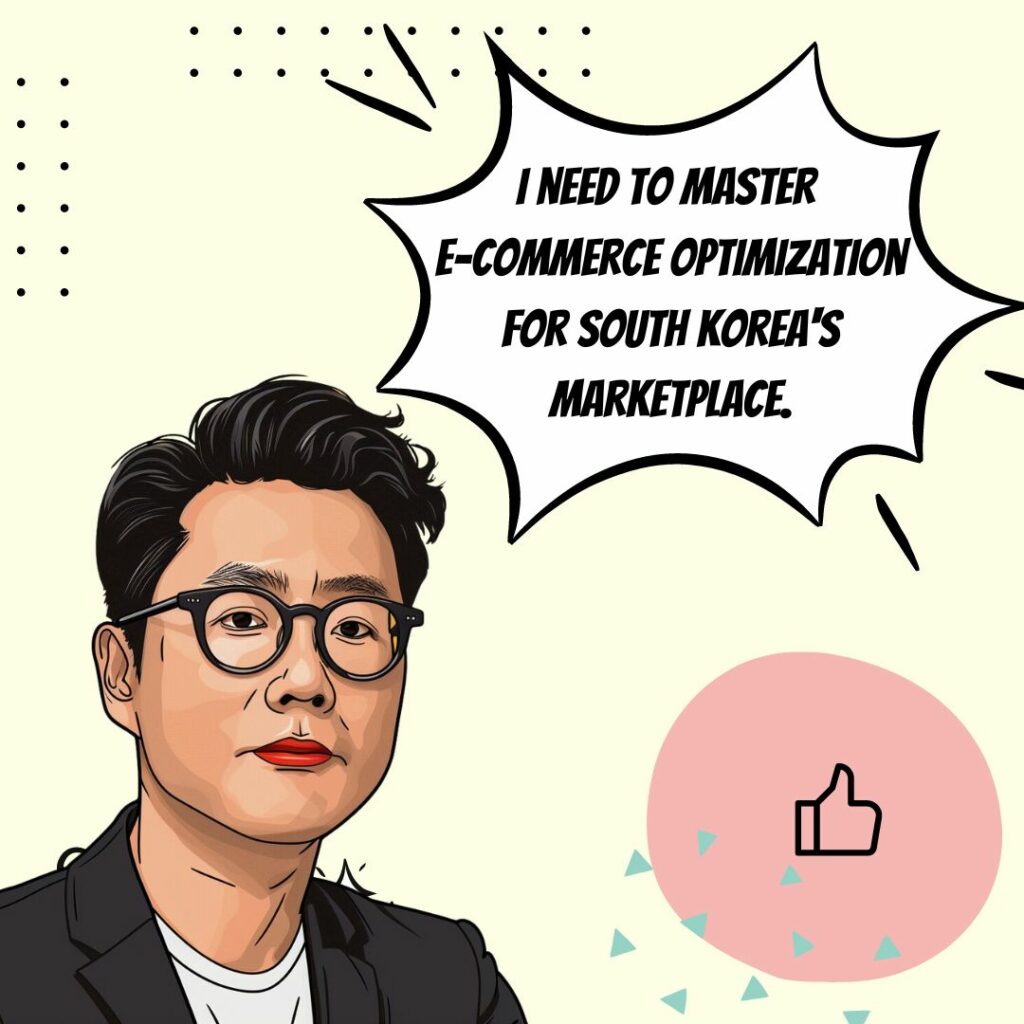Key Takeaways
✅ Mobile-First Approach: With a staggering number of people tapping and scrolling their way to purchases, if your website isn't slick on smartphones, you're missing out. In South Korea, you've got to think 'mobile first' to keep shoppers happy and the sales flowing.
✅ Localized Payment Methods: Ever tried to buy something online but gave up because paying was a hassle? South Koreans feel the same way. Make their lives easier with local favorites like KakaoPay, and watch those one-click checkouts turn into sales.
✅ Social Commerce Integration: Imagine having a shop where your customers hang out all the time like KakaoTalk or Instagram. Well, you can. Tapping into social commerce opens up a world of opportunity, from chatting with shoppers to making every post a potential sale.

Introduction
Ever wonder why some e-commerce stars shine bright in South Korea's online sky while others barely twinkle? It's not down to luck. It's about knowing the local market and delivering what customers want, the way they like it. Think of South Korea as a giant, fast-paced digital shopping mall. Everyone's got a smartphone glued to their hand, ready to snap up deals that are just right for them. The question is, how do you get your store to be the one they can't walk past, or better yet, can't stop visiting?
Here's where the magic happens. We're diving deep into South Korea's unique online shopping ecosystem, bringing you the inside track on what ticks for consumers and how you can tune your e-commerce store to hit all the right notes. Whether it's the latest mobile shopping hacks, making payment as easy as pie, or using social media like a seasoned pro, we've got the insights that could turn browsers into buyers and likes into leads.
So, buckle up! It's time to explore uncharted strategies and learn how you can amp up your online presence to not just meet, but exceed the South Korean market's expectations. Scalable growth? Better ROI? It's all within reach—and this article is your road map.
South Korea's E-commerce Landscape
Imagine a bustling digital marketplace, filled to the brim with savvy shoppers glued to their screens. South Korea's e-commerce market is just that—a hub of online activity where the latest trends meet cutting-edge technology. Yet, diving into this world without understanding the local preferences and trends is like navigating a bustling city without a map. Why do Koreans prefer certain websites over others? What makes their online shopping tick?
Understanding South Korean Consumers
What's unique about a South Korean shopper? They're fiercely modern yet deeply traditional, bridging the gap between high-tech and high-touch experiences. The key demographic swings young, tech-savvy, and eager for convenience. But beyond the gadgets and gizmos, there's a cultural layer that influences online shopping behavior—a blend of trends and traditions. So, when setting up shop, how do you ensure that your payment methods are on par with their preferred payment methods? Do you know the local hot-ticket items that make fast shipping a day-to-day expectation?
Best Practices for Website Localization
Here’s the thing about websites: if yours doesn’t speak the local lingo, you might as well be whispering into the void. Language and translation considerations are more than just swapping words; it's about conveying warmth and personality. And let's talk about money—currency and payment options need to be as familiar as kimchi on a Korean dinner table. But what's the secret sauce in crafting a user experience that resonates with a South Korean customer?
Optimizing for Mobile Shopping
Ever seen someone buy a fridge on their phone while riding the subway? In South Korea, this is just another Monday. Mobile commerce isn't just an option; it's the lifeblood of the online market. With phones acting as shopping carts, ensuring responsive design isn't just a suggestion—it's a must. Yet, are those mobile-friendly features enough to win trust, or is there more to the story when it comes to mobile payment options and security?
Social Media and Influencer Marketing
Think of social media as the boisterous town square where everyone comes to chatter, gawk, and shop. South Korea's digital community is always on the pulse, making popular social media platforms vital arenas for engagement. Influencers? They're the local heroes, guiding opinions and opening wallets. But with every brand vying for attention, what are the influencer marketing strategies that truly connect and convert fans into customers?
Fulfillment and Logistics
Want to know what makes a South Korean online shopper tick? It's simple: speed. The expectation for fast and reliable delivery is sky-high, and not meeting it is akin to running out of gas mid-race. Joining forces with local logistics providers can shift your delivery game from tortoise to hare. But what happens after the sale? How do you handle the thorny issues of returns and customer service without losing face or customers?
By acquainting yourself with the unique nuances of South Korea's shopping ecosystem, you can tailor your e-commerce ventures to resonate with the local crowd. There’s more to this market than meets the eye, and understanding these idiosyncrasies might just be your golden ticket to thriving in a market that’s as dynamic as it is demanding. Will you adapt and soar, or overlook these insights and watch opportunities pass you by?
AI Marketing Engineers Recommendation
Recommendation 1: Leverage Mobile Commerce Innovation: With over 90% of South Korea's population using smartphones, mobile commerce isn't just a trend; it's a lifestyle. Optimize for mobile-first shopping experiences by ensuring your e-commerce platform is ultra-responsive and offers a seamless purchasing process right from the device in their hands.
Recommendation 2: Utilize Localized Social Commerce Strategies: Social media isn't just about likes and shares in South Korea; it's a serious shopping platform. Platforms like KakaoTalk and Naver are not just popular, they're essential for daily life. Integrate social commerce by partnering with local influencers, embracing social storefronts, and providing exclusive deals through these channels.
Recommendation 3: Adopt Local Payment Preferences: Did you know that South Koreans prefer to use their own payment systems like KakaoPay and Naver Pay? To really connect with buyers, it's crucial to integrate these payment options into your checkout process. This shows respect for local habits and can significantly reduce cart abandonment rates.
Relevant Links
- Taking Your Affiliate Marketing to New Heights in 2024
- Dive Into the Future: Top Digital Marketing Trends You Can't Ignore
- Unlock the Secret to E-Commerce Success with Persuasive Google Ads
- Choosing the Winning Tactics: Your SEO Strategy Decoded
- Maximizing Mobile Engagement: How to Win Over the South Korean Shopper
Conclusion
As we wrap up our journey through the bustling digital streets of South Korea's online marketplaces, take a moment to soak in the vibrant landscape we've explored. It's a world where tradition meets technology, and where consumer understanding is the golden ticket to success in e-commerce optimization. You've seen how South Koreans click, tap, and swipe their way through shopping with unique preferences and expectations. From the youthful zest influencing social media trends to the meticulous demands for swift shipping, every bit of knowledge shapes your storefront's future.
But what does all this mean for you and your brand? Well, imagine adapting your online shop with the finesse of a local, charming your way into the hearts of these tech-savvy shoppers. Remember, the key is to blend in, speaking their language both metaphorically and literally, offering the payment options they trust, and ensuring your mobile presence is as strong and user-friendly as a local app.
So, have you thought about how your brand can integrate these best practices for a future in South Korea's e-commerce scene? Can you see the opportunities dancing on the horizon, ready for you to grab them? It's not just about joining the flow; it's about riding the wave with the finesse of a seasoned surfer. Dive in, adapt, and optimize; South Korea's e-commerce ecosystem awaits your unique touch.
FAQs
Question 1: What are the key differences between South Korea's e-commerce landscape and other global markets?
Answer: South Korea's e-commerce market stands out with its high internet penetration rate, a population that prefers shopping on their phones, and a special kind of love for local tech wonders like Naver and Kakao. Don't forget how much social media sways what folks buy online.
Question 2: What are the most popular e-commerce platforms in South Korea?
Answer: When it comes to shopping online in South Korea, Coupang, Gmarket, 11st, and SSG.com are where the party's at. Naver and Kakao are also key players, with their social media magic that turns browsing into buying.
Question 3: How important is mobile optimization for South Korean e-commerce websites?
Answer: Think of mobile optimization as the VIP pass for online stores in South Korea. With nearly everyone using their smartphones to shop, if a site doesn't play nice with mobile, it's basically invisible.
Question 4: What are some best practices for optimizing e-commerce websites for South Korean consumers?
Answer: Want to win over South Korean shoppers? Speak their language, offer many ways to pay, get orders to doorsteps pronto, flaunt your social media savvy, and let customer praise sing your product's praises.
Question 5: How does social media influence e-commerce in South Korea?
Answer: In South Korea, social media isn't just for selfies and snacks—it's a digital marketplace! It plays matchmaker between consumers and brand-new products, fuels conversations, and builds brand love.
Question 6: What are some common payment methods used by South Korean online shoppers?
Answer: Break out the credit cards, wire some funds, or tap into digital wallets like KakaoPay and Naver Pay. Variety is the spice of life—and South Korean e-shoppers have a spicy palette for payment options.
Question 7: How important is fast and reliable delivery for South Korean e-commerce customers?
Answer: Quick and reliable delivery in South Korea is like morning coffee—absolutely essential. Shoppers expect their goodies fast, and on time. So, e-commerce folks better step on it if they want to keep their customers smiling.
Question 8: What role does customer service play in South Korean e-commerce?
Answer: Customer service is the superhero of the South Korean e-commerce world. Shoppers want answers fast, and they want them now—whether that's through chat, email, or a good old-fashioned phone call.
Question 9: How can e-commerce businesses effectively market their products to South Korean consumers?
Answer: To get your goods noticed in South Korea, start social mingling on platforms like Naver, team up with influencers who know their kimchi from their kombucha, make your website a favorite for local searches, and tempt with deals that scream 'bargain'.
Question 10: What are some common challenges faced by e-commerce businesses in South Korea, and how can they be addressed?
Answer: Navigating e-commerce in South Korea can be as tricky as a K-drama plot twist. Think language snafus, elbowing through competitors, and hoops of regulations. The secret? Team up with local wizards, tailor your approach, and always play by the rules.
Academic References
- Kim, S., & Park, Y. (2019). E-commerce in South Korea: Understanding the Online Consumer. International Journal of E-Business and E-Government Studies, 11(3), 55-66. This insightful piece gives us a peek into the minds of South Korean online shoppers. What ticks their boxes, how they think, and what they do before hitting that "buy" button. It's like having a little roadmap to e-commerce success in South Korea!
- Lee, J. H., & Lee, J. (2019). The Influence of Social Media on Online Purchase Intention in South Korea: The Mediating Role of Trust. Journal of Retailing and Consumer Services, 49, 105-113. Got a minute to talk about trust? This study shows just how much social media can sway buyers in South Korea, but only if they trust what they see. It's a nudge for e-commerce whizzes to amp up the trust factor and connect with customers where they hang out.
- Kim, S., & Park, Y. (2016). Mobile Commerce in South Korea: A Comprehensive Review and Future Research Directions. International Journal of Mobile Communications, 14(3), 205-222. In South Korea, smartphones are more than just gadgets; they're shopping companions. This paper dives into the rise of mobile commerce and drops hints on how businesses can get cozy with mobile users.
- Lee, J. H., & Lee, J. (2017). Understanding the Factors Affecting Online Shopping Behavior in South Korea: An Extension of the Technology Acceptance Model. Journal of Retailing and Consumer Services, 39, 135-146. Ever wonder what makes someone click "add to cart"? This study extends a classic tech model to dissect the online shopping behavior in South Korea. It's all about getting into the consumer's headspace and tweaking that e-commerce strategy accordingly.












